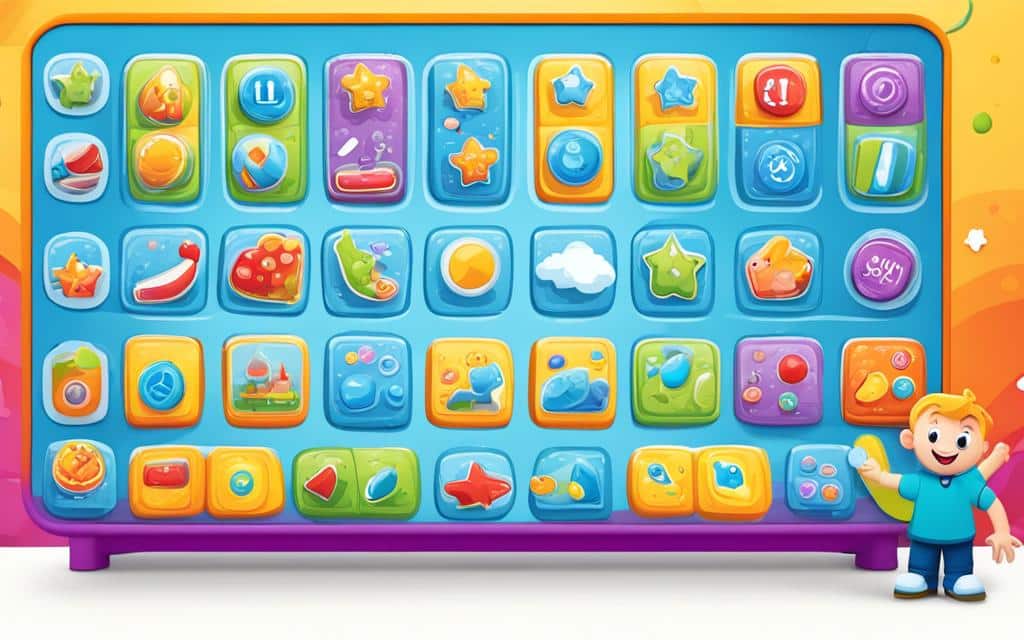Table of Contents
When it comes to designing interactive experiences for children, there are specific principles and considerations that need to be taken into account. Children have unique cognitive development needs, and their understanding of instructions and user interfaces differs from adults. As designers, we must consider their abilities and tailor our designs to provide an engaging and educational experience.
One essential principle is to give clear and specific instructions that cater to children’s level of understanding. This helps them grasp the goal of a game or task and navigate through the interface effectively. Leveraging their existing mental models and knowledge is another crucial consideration. By designing interfaces that align with their prior knowledge and experiences, we reduce the cognitive load and make it easier for children to interact with our designs.
Children’s cognitive development can be categorized into different stages, such as the preoperational stage (ages 2-7) and the concrete operational stage (ages 7-11). Understanding these stages and their cognitive abilities is vital when designing for children.
Additionally, ethical considerations are significant when designing for children. Ensuring their safety and privacy, avoiding harmful content, and creating inclusive experiences are essential. Adhering to regulations and guidelines for children’s online safety and privacy is crucial. As designers, we play a role in promoting positive social interactions and considering children from diverse backgrounds and abilities.
Emotional design also plays a crucial role in children’s apps. By triggering positive emotions, such as joy, curiosity, and excitement, we enhance their engagement and enjoyment of the app. Attention should also be given to feedback and emotional responses, providing appropriate and timely feedback to keep children interested and satisfied.
In different sectors, such as educational apps, gaming platforms, digital storybooks, and health and wellness apps, interactive design for children is in high demand. These sectors aim to provide engaging and educational experiences that contribute to children’s development. Designers in these sectors must understand the unique requirements and considerations when creating interactive designs for children.
By following the principles and considerations outlined above, designers can create interactive experiences that not only engage children but also promote their cognitive development, safety, and emotional well-being. In the following sections, we will explore Piaget’s Development Theory, dive deeper into design recommendations, discuss ethical considerations, explore emotional design, and examine the different sectors that require interactive design for children.
Piaget’s Development Theory
Piaget’s Development Theory provides valuable insights into the stages of cognitive development in children. Understanding these stages is crucial for designing interactive experiences that align with children’s cognitive abilities and promote optimal learning and engagement.
The Preoperational Stage
The preoperational stage, which typically occurs between the ages of 2 and 7, is characterized by significant cognitive growth. During this stage, children begin to use symbols and represent objects and events mentally. However, they struggle to take others’ perspectives and often exhibit egocentric thinking.
Children in the preoperational stage show remarkable linguistic and imaginative abilities. They engage in pretend play, use symbols to represent objects, and are increasingly able to engage in imaginative thinking. However, their thinking is often illogical and influenced by their limited perspective.
The Concrete Operational Stage
The concrete operational stage typically spans from ages 7 to 11 and marks a significant shift in children’s cognitive abilities. During this stage, children become more capable of using logical reasoning and making inferences based on concrete experiences.
Children in the concrete operational stage demonstrate improved understanding of mental operations and the ability to solve problems systematically. They develop conservation skills, grasp the concept of reversibility, and exhibit an increased awareness of cause and effect relationships. Their thinking becomes more organized and less influenced by purely perceptual considerations.
It is important to note that cognitive development is not limited to these two stages. Other key cognitive capacities continue to develop in children, including theory of mind, cognitive flexibility, and executive function. These aspects contribute to the complexity of children’s cognitive abilities and should be considered when designing interactive experiences that cater to their unique needs.
| Key Features | Preoperational Stage (Ages 2-7) | Concrete Operational Stage (Ages 7-11) |
|---|---|---|
| Symbolic Thinking | Children can think in terms of symbols and use language to represent objects and events. | Children develop more sophisticated symbolic thinking and can use logic to reason. |
| Perspective Taking | Children struggle to take others’ perspectives and often exhibit egocentric thinking. | Children become more capable of understanding others’ perspectives and consider multiple viewpoints. |
| Logical Reasoning | Thinking is often illogical and influenced by limited perspective. | Children demonstrate improved logical reasoning skills and can make inferences based on concrete experiences. |
Understanding Piaget’s Development Theory and the different stages of cognitive development provides a solid foundation for designing interactive experiences that are suitable for children at various ages. By tailoring interactive design to children’s cognitive abilities and developmental stage, designers can create engaging and educational experiences that foster cognitive growth and knowledge acquisition.
Design Recommendations
When it comes to interactive design for children, there are several key recommendations that can help create engaging and user-friendly experiences. These design recommendations aim to optimize children’s understanding and interaction with digital interfaces, ensuring a positive and enjoyable experience.
Clear and Specific Instructions
One important design recommendation is to provide clear and specific instructions. Children rely on explicit guidance to understand the goal of a game or task and how to achieve it. By offering concise and easily understandable instructions, designers can minimize confusion and enhance children’s comprehension. This helps children navigate through interactive elements and accomplish tasks effectively.
Tailor Instructions to the Child’s Level of Understanding
Another crucial aspect of interactive design for children is to tailor instructions to their level of understanding. Children have different cognitive abilities based on their age and developmental stage. By considering their cognitive capabilities, designers can ensure that instructions are comprehensible and appropriate. This personalized approach enables children to engage with digital interfaces confidently and independently.
Utilize Existing Mental Models and Knowledge
Designers should leverage children’s existing mental models and knowledge when creating interactive experiences. Children rely on their past experiences and prior knowledge to make sense of new information and interactions. By incorporating familiar concepts and elements, designers can improve children’s ability to navigate through websites or apps. This not only reduces the cognitive load but also enhances children’s confidence and engagement.
Reduce Cognitive Load with Self-Explanatory Interfaces
Designing self-explanatory interfaces is an effective way to reduce cognitive load for children. Self-explanatory interfaces are intuitive and require minimal cognitive effort to understand and interact with. By providing visual cues, feedback, and logical sequencing, designers can minimize the mental resources needed for children to navigate through the system. This promotes a seamless and enjoyable user experience.
These design recommendations form the foundation for creating interactive designs that are optimized for children. By giving clear instructions, tailoring them to the child’s level of understanding, utilizing existing mental models and knowledge, and reducing cognitive load through self-explanatory interfaces, designers can ensure that children can easily interact with and benefit from digital experiences. By following these recommendations, interactive designs can engage and inspire children in a safe and educational manner.
Ethical Considerations in Designing for Children
When designing interactive experiences for children, ethical considerations should be taken into account. Designers have a responsibility to ensure the safety and privacy of children, as well as to avoid harmful or age-inappropriate content. Additionally, promoting positive social interactions is crucial for creating a healthy digital environment for children.
Adhering to regulations and guidelines for children’s online safety and privacy is essential. This includes obtaining parental consent for data collection and implementing measures to protect children from potential risks. By prioritizing the well-being of children, designers can build trust and establish a secure online environment.
Creating inclusive experiences that cater to children from diverse backgrounds and abilities is also important. The interactive design should consider accessibility features to accommodate children with disabilities and provide an equal opportunity for engagement and participation.
Designing for children requires a commitment to ethical practices that prioritize their well-being and ensure a positive and inclusive digital experience.
By considering these ethical considerations, designers can contribute to the development of interactive design solutions that are not only engaging and educational but also safe and socially responsible.
| Ethical Considerations | Actions |
|---|---|
| Safety and Privacy | Implement parental consent processes for data collection. Ensure secure and age-appropriate content. |
| Inclusivity | Design accessible features to cater to children with disabilities. Consider diverse backgrounds and abilities. |
| Social Responsibility | Promote positive social interactions and discourage harmful behavior. Foster a supportive online community. |
Emotional Design for Children’s Apps
Emotional design plays a crucial role in creating positive user experiences for children’s apps. Children engage with apps on emotional, sensorimotor, and verbal levels, and their emotional needs should be considered in the design process.
Designers should aim to trigger positive emotions in children, such as joy, curiosity, and excitement, to enhance their engagement and enjoyment of the app. By creating a visually appealing and interactive interface, designers can stimulate emotional responses and establish a strong connection between the child and the app.
“Engaging children emotionally is vital for the success of an app. By creating a captivating and appealing design, we can evoke positive emotions that will keep children entertained and motivated to use the app.”
– Sarah Davis, Lead UX Designer
Attention should also be given to feedback and the emotional responses of children. Providing appropriate and timely feedback is essential to keep children interested and satisfied. By acknowledging their achievements and progress, apps can reinforce positive emotions and contribute to a rewarding user experience.
When designing for emotional needs, it is important to consider elements such as colors, characters, and animations that can evoke specific emotions. For example, bright and vibrant colors can elicit happiness and excitement, while friendly and relatable characters can create a sense of trust and companionship.
To illustrate the impact of emotional design in children’s apps, let’s take a look at an example of an app that effectively utilizes emotional design:
Mood Magic – A Case Study
“Mood Magic” is an interactive app that helps children understand and manage their emotions. Through engaging activities and age-appropriate content, the app enables children to explore different emotions in a fun and interactive way.
The design of Mood Magic incorporates various elements to stimulate emotional responses. The use of vibrant colors and playful animations creates an atmosphere of excitement and curiosity, inviting children to explore and engage with the app. The app also provides personalized feedback and rewards, boosting children’s self-esteem and fostering a positive emotional experience.
Here is a comparison table showcasing the key emotional design elements in “Mood Magic” and their impact on user engagement:
| Emotional Design Element | Impact on User Engagement |
|---|---|
| Colorful and Vibrant Interface | Creates a sense of excitement and captures children’s attention. |
| Friendly and Expressive Characters | Builds trust and emotional connection, making children feel comfortable and understood. |
| Interactive Animations | Enhances engagement and encourages active participation, making the app more enjoyable for children. |
| Personalized Feedback and Rewards | Boosts children’s motivation and self-esteem, reinforcing positive emotional experiences. |
Through thoughtful emotional design, “Mood Magic” effectively captures the attention and emotions of its young users, creating an engaging and enjoyable experience that supports their emotional well-being.
By incorporating emotional design principles into children’s apps, designers can ensure that the user experience is not only educational and interactive but also emotionally rewarding. Understanding and responding to children’s emotional needs can greatly enhance their engagement and enjoyment of the app, fostering a positive and impactful interaction.
Sectors Requiring Interactive Design for Kids
Interactive design plays a vital role in several sectors aimed at children. These sectors include educational apps, gaming platforms, digital storybooks, and health and wellness apps. Each sector has unique goals and benefits for children, ensuring their engagement, learning, and well-being. Let’s explore each sector in detail:
Educational Apps
Educational apps are designed to help children develop essential skills while providing engaging learning experiences. These apps offer interactive activities and games that foster cognitive development, problem-solving abilities, creativity, and critical thinking. By integrating interactive design elements, such as quizzes, puzzles, and simulations, educational apps create an immersive environment that encourages active participation and knowledge retention.
Gaming Platforms
Gaming platforms for children offer not only entertainment but also opportunities for cognitive development. These platforms feature age-appropriate games that challenge children’s problem-solving skills, strategic thinking, and hand-eye coordination. Interactive design in gaming platforms ensures intuitive gameplay, clear instructions, and engaging visuals and sound effects that captivate children’s attention and enhance their gaming experience.
Digital Storybooks
Digital storybooks combine traditional storytelling with interactive design to captivate children’s imagination and promote language development. These interactive books often incorporate animated illustrations, interactive elements, and audio narration, enhancing children’s engagement and comprehension. By allowing children to interact with the story, digital storybooks foster a love for reading and nurture language skills.
Health and Wellness Apps
Health and wellness apps designed for children focus on promoting physical and mental well-being. These apps provide interactive features such as fitness challenges, mindfulness exercises, nutritional guidance, and emotional support. By utilizing interactive design, health and wellness apps help children understand their needs and encourage healthy habits, empowering them to take charge of their overall wellness.
Interactive design plays a crucial role in enhancing children’s experiences in these sectors. By creating engaging and user-friendly interfaces, interactive design facilitates learning, entertainment, language development, and overall well-being for children.
Conclusion
In conclusion, interactive design for children should take into account their cognitive development stage, provide clear and specific instructions, tailor instructions to their level of understanding, utilize existing mental models and knowledge, and minimize cognitive load. Ethical considerations, such as ensuring safety and privacy, are crucial in designing for children. The incorporation of emotional design is also essential, as it stimulates positive emotions and enhances engagement in children’s apps.
Multiple sectors, including educational apps, gaming platforms, digital storybooks, and health and wellness apps, demand interactive design for children. By following these principles and considerations, designers can create interactive experiences that promote engagement and foster children’s learning and development.
Designing interactive experiences for children requires careful thought and consideration. By incorporating these principles and addressing the specific needs of children, designers can create meaningful and impactful experiences that enhance children’s cognitive abilities, spark their curiosity, and foster their growth.
FAQ
What is Piaget’s Development Theory?
Piaget’s Development Theory explains the different stages of children’s cognitive development. It categorizes children’s cognitive abilities into the preoperational stage (ages 2-7) and the concrete operational stage (ages 7-11).
What are the design recommendations for interactive design for children?
Design recommendations for interactive design for children include giving clear and specific instructions, tailoring instructions to the child’s level of understanding, using existing mental models and knowledge, and reducing cognitive load by designing self-explanatory interfaces.
What ethical considerations should be taken into account when designing for children?
Ethical considerations for designing for children include ensuring the safety and privacy of children, avoiding harmful or age-inappropriate content, and promoting positive social interactions. Designers should comply with regulations and guidelines for children’s online safety and privacy.
What role does emotional design play in children’s apps?
Emotional design plays a crucial role in creating positive user experiences for children’s apps. Designers should aim to trigger positive emotions in children, such as joy, curiosity, and excitement, to enhance their engagement and enjoyment of the app.
Which sectors require interactive design for children?
Several sectors require interactive design for children, including educational apps, gaming platforms, digital storybooks, and health and wellness apps. These sectors provide opportunities for learning, cognitive development, and entertainment for children.
What are the principles and considerations for interactive design for children?
Interactive design for children should consider their cognitive development stage, provide clear and specific instructions, tailor instructions to their level of understanding, use existing mental models and knowledge, and reduce cognitive load. Ethical considerations, such as safety and privacy, should also be taken into account.













